Nursing Management of Bronchiolitis: Assessment, Care, and Discharge
VerifiedAdded on 2020/06/03
|10
|2654
|180
Report
AI Summary
This report presents a comprehensive nursing case study focusing on an 18-month-old boy, Travis, diagnosed with bronchiolitis. It begins with an introduction to bronchiolitis, its pathophysiology, and the role of Respiratory Syncytial Virus (RSV). The assessment section details Travis's respiratory, general, integumentary, cardiovascular, CNS, and social conditions, highlighting relevant symptoms such as tachypnea, hypoxia, and a family history of asthma. The nursing care section outlines essential interventions, including parent education, hydration strategies, oxygenation, and the use of saline nasal drops. Discharge planning covers dietary advice, breastfeeding promotion, patient education on smoking cessation and positioning, and medication guidance. The report emphasizes the importance of parental involvement in decision-making, adhering to ethical principles, and providing comprehensive care to manage the symptoms and prevent complications associated with bronchiolitis. The report highlights the importance of ongoing patient education and care to ensure a smooth recovery and prevent future complications.
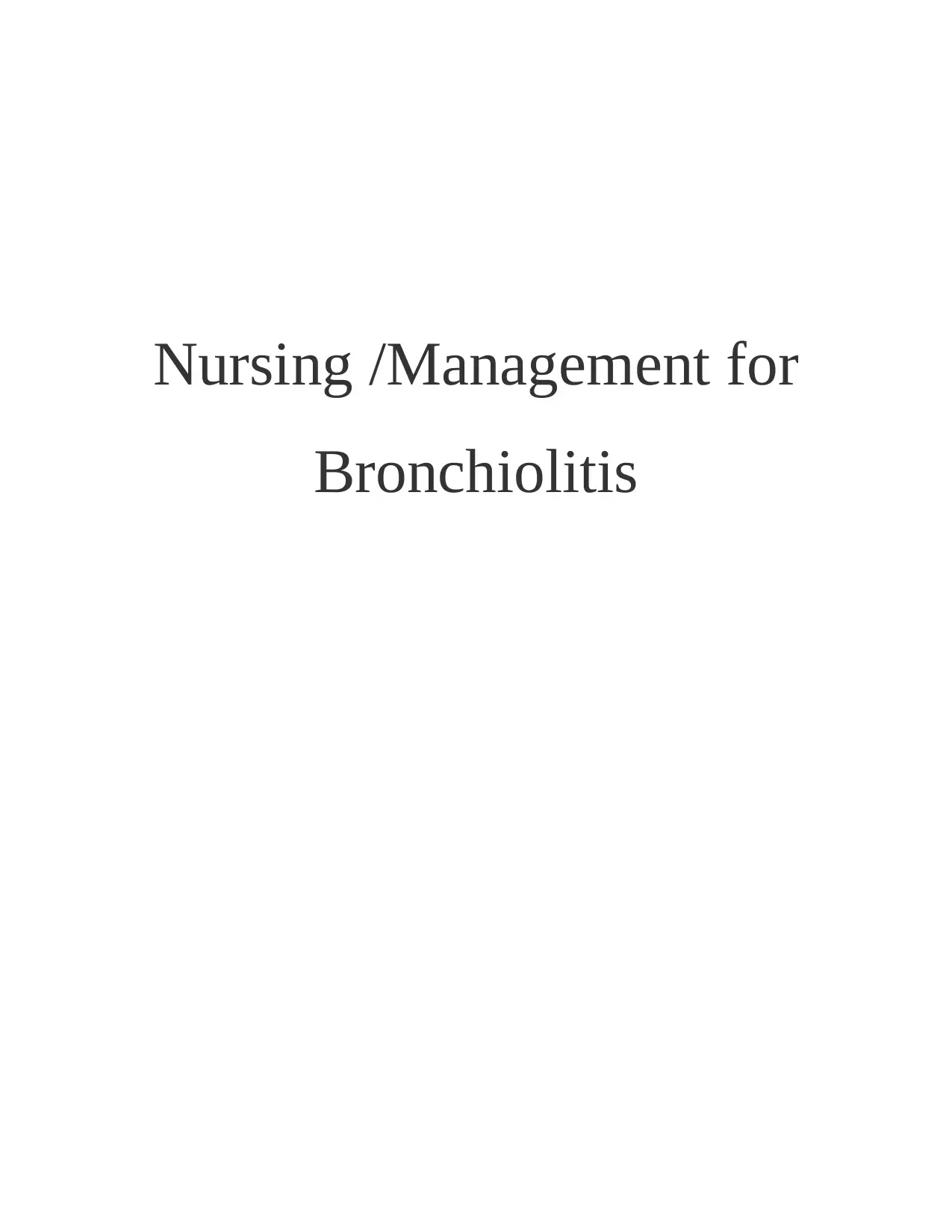
Nursing /Management for
Bronchiolitis
Bronchiolitis
Paraphrase This Document
Need a fresh take? Get an instant paraphrase of this document with our AI Paraphraser

TABLE OF CONTENTS
INTRODUCTION...........................................................................................................................1
Pathophysiology..........................................................................................................................1
Assessment ................................................................................................................................2
Nursing care................................................................................................................................3
Discharge Section........................................................................................................................5
CONCLUSION................................................................................................................................6
REFERENCES................................................................................................................................7
INTRODUCTION...........................................................................................................................1
Pathophysiology..........................................................................................................................1
Assessment ................................................................................................................................2
Nursing care................................................................................................................................3
Discharge Section........................................................................................................................5
CONCLUSION................................................................................................................................6
REFERENCES................................................................................................................................7
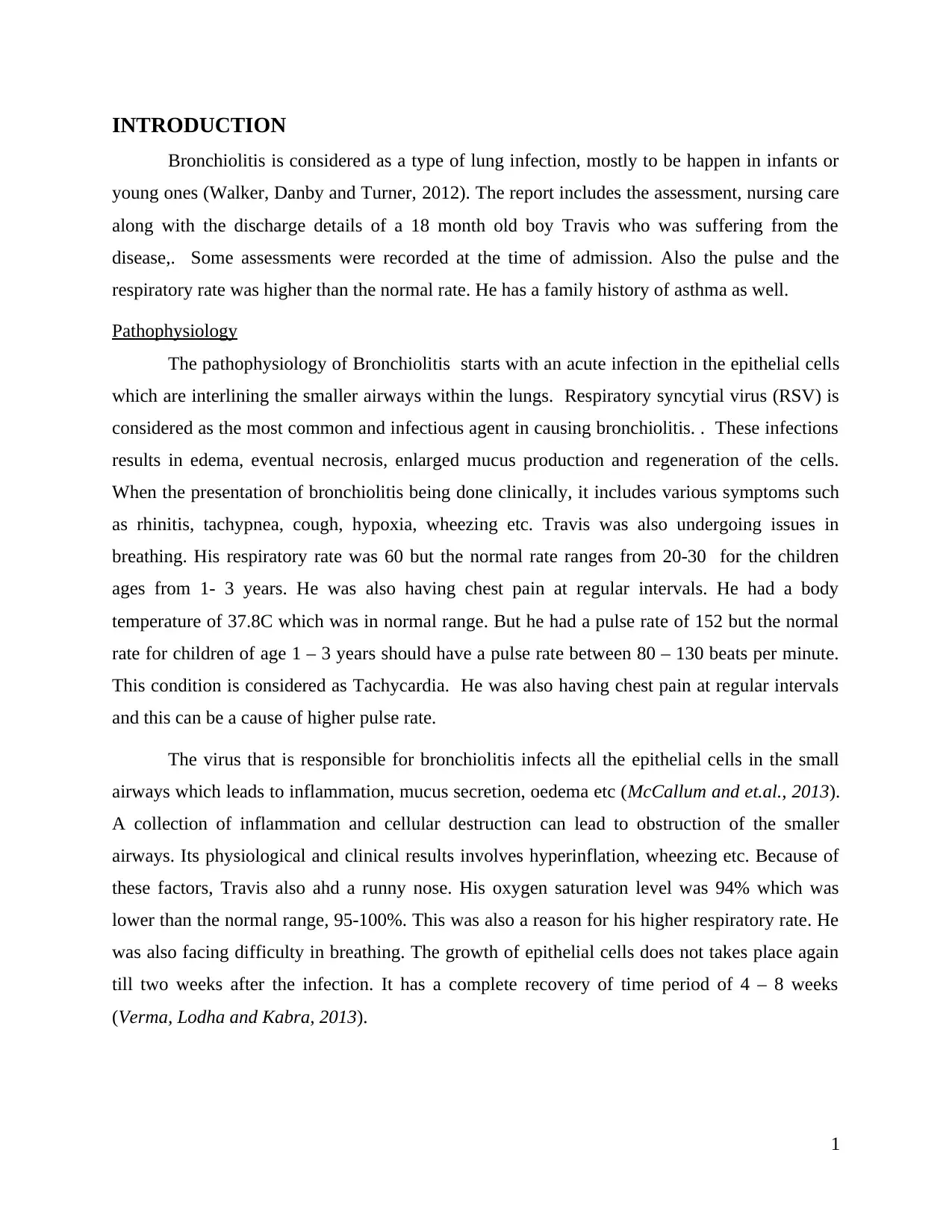
INTRODUCTION
Bronchiolitis is considered as a type of lung infection, mostly to be happen in infants or
young ones (Walker, Danby and Turner, 2012). The report includes the assessment, nursing care
along with the discharge details of a 18 month old boy Travis who was suffering from the
disease,. Some assessments were recorded at the time of admission. Also the pulse and the
respiratory rate was higher than the normal rate. He has a family history of asthma as well.
Pathophysiology
The pathophysiology of Bronchiolitis starts with an acute infection in the epithelial cells
which are interlining the smaller airways within the lungs. Respiratory syncytial virus (RSV) is
considered as the most common and infectious agent in causing bronchiolitis. . These infections
results in edema, eventual necrosis, enlarged mucus production and regeneration of the cells.
When the presentation of bronchiolitis being done clinically, it includes various symptoms such
as rhinitis, tachypnea, cough, hypoxia, wheezing etc. Travis was also undergoing issues in
breathing. His respiratory rate was 60 but the normal rate ranges from 20-30 for the children
ages from 1- 3 years. He was also having chest pain at regular intervals. He had a body
temperature of 37.8C which was in normal range. But he had a pulse rate of 152 but the normal
rate for children of age 1 – 3 years should have a pulse rate between 80 – 130 beats per minute.
This condition is considered as Tachycardia. He was also having chest pain at regular intervals
and this can be a cause of higher pulse rate.
The virus that is responsible for bronchiolitis infects all the epithelial cells in the small
airways which leads to inflammation, mucus secretion, oedema etc (McCallum and et.al., 2013).
A collection of inflammation and cellular destruction can lead to obstruction of the smaller
airways. Its physiological and clinical results involves hyperinflation, wheezing etc. Because of
these factors, Travis also ahd a runny nose. His oxygen saturation level was 94% which was
lower than the normal range, 95-100%. This was also a reason for his higher respiratory rate. He
was also facing difficulty in breathing. The growth of epithelial cells does not takes place again
till two weeks after the infection. It has a complete recovery of time period of 4 – 8 weeks
(Verma, Lodha and Kabra, 2013).
1
Bronchiolitis is considered as a type of lung infection, mostly to be happen in infants or
young ones (Walker, Danby and Turner, 2012). The report includes the assessment, nursing care
along with the discharge details of a 18 month old boy Travis who was suffering from the
disease,. Some assessments were recorded at the time of admission. Also the pulse and the
respiratory rate was higher than the normal rate. He has a family history of asthma as well.
Pathophysiology
The pathophysiology of Bronchiolitis starts with an acute infection in the epithelial cells
which are interlining the smaller airways within the lungs. Respiratory syncytial virus (RSV) is
considered as the most common and infectious agent in causing bronchiolitis. . These infections
results in edema, eventual necrosis, enlarged mucus production and regeneration of the cells.
When the presentation of bronchiolitis being done clinically, it includes various symptoms such
as rhinitis, tachypnea, cough, hypoxia, wheezing etc. Travis was also undergoing issues in
breathing. His respiratory rate was 60 but the normal rate ranges from 20-30 for the children
ages from 1- 3 years. He was also having chest pain at regular intervals. He had a body
temperature of 37.8C which was in normal range. But he had a pulse rate of 152 but the normal
rate for children of age 1 – 3 years should have a pulse rate between 80 – 130 beats per minute.
This condition is considered as Tachycardia. He was also having chest pain at regular intervals
and this can be a cause of higher pulse rate.
The virus that is responsible for bronchiolitis infects all the epithelial cells in the small
airways which leads to inflammation, mucus secretion, oedema etc (McCallum and et.al., 2013).
A collection of inflammation and cellular destruction can lead to obstruction of the smaller
airways. Its physiological and clinical results involves hyperinflation, wheezing etc. Because of
these factors, Travis also ahd a runny nose. His oxygen saturation level was 94% which was
lower than the normal range, 95-100%. This was also a reason for his higher respiratory rate. He
was also facing difficulty in breathing. The growth of epithelial cells does not takes place again
till two weeks after the infection. It has a complete recovery of time period of 4 – 8 weeks
(Verma, Lodha and Kabra, 2013).
1
⊘ This is a preview!⊘
Do you want full access?
Subscribe today to unlock all pages.

Trusted by 1+ million students worldwide
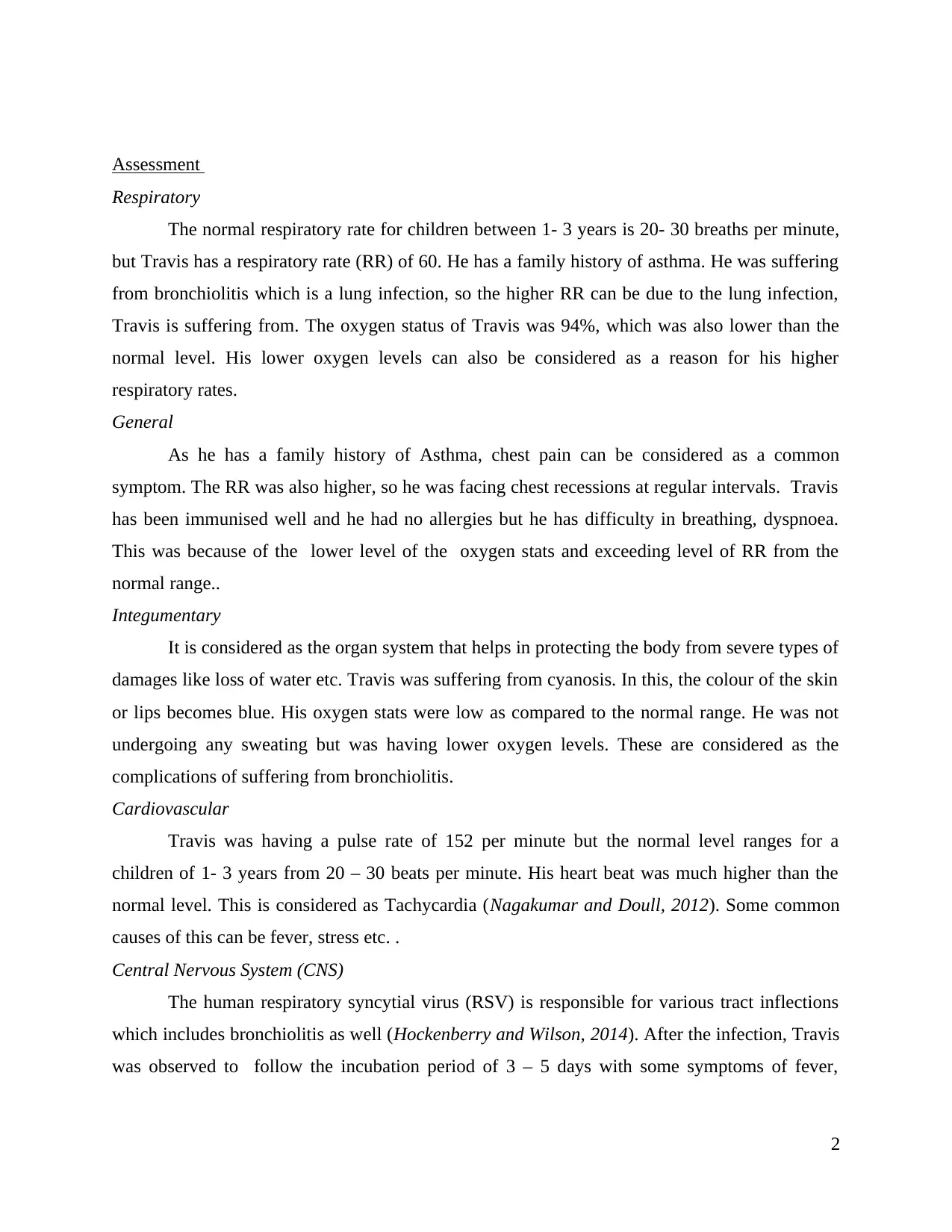
Assessment
Respiratory
The normal respiratory rate for children between 1- 3 years is 20- 30 breaths per minute,
but Travis has a respiratory rate (RR) of 60. He has a family history of asthma. He was suffering
from bronchiolitis which is a lung infection, so the higher RR can be due to the lung infection,
Travis is suffering from. The oxygen status of Travis was 94%, which was also lower than the
normal level. His lower oxygen levels can also be considered as a reason for his higher
respiratory rates.
General
As he has a family history of Asthma, chest pain can be considered as a common
symptom. The RR was also higher, so he was facing chest recessions at regular intervals. Travis
has been immunised well and he had no allergies but he has difficulty in breathing, dyspnoea.
This was because of the lower level of the oxygen stats and exceeding level of RR from the
normal range..
Integumentary
It is considered as the organ system that helps in protecting the body from severe types of
damages like loss of water etc. Travis was suffering from cyanosis. In this, the colour of the skin
or lips becomes blue. His oxygen stats were low as compared to the normal range. He was not
undergoing any sweating but was having lower oxygen levels. These are considered as the
complications of suffering from bronchiolitis.
Cardiovascular
Travis was having a pulse rate of 152 per minute but the normal level ranges for a
children of 1- 3 years from 20 – 30 beats per minute. His heart beat was much higher than the
normal level. This is considered as Tachycardia (Nagakumar and Doull, 2012). Some common
causes of this can be fever, stress etc. .
Central Nervous System (CNS)
The human respiratory syncytial virus (RSV) is responsible for various tract inflections
which includes bronchiolitis as well (Hockenberry and Wilson, 2014). After the infection, Travis
was observed to follow the incubation period of 3 – 5 days with some symptoms of fever,
2
Respiratory
The normal respiratory rate for children between 1- 3 years is 20- 30 breaths per minute,
but Travis has a respiratory rate (RR) of 60. He has a family history of asthma. He was suffering
from bronchiolitis which is a lung infection, so the higher RR can be due to the lung infection,
Travis is suffering from. The oxygen status of Travis was 94%, which was also lower than the
normal level. His lower oxygen levels can also be considered as a reason for his higher
respiratory rates.
General
As he has a family history of Asthma, chest pain can be considered as a common
symptom. The RR was also higher, so he was facing chest recessions at regular intervals. Travis
has been immunised well and he had no allergies but he has difficulty in breathing, dyspnoea.
This was because of the lower level of the oxygen stats and exceeding level of RR from the
normal range..
Integumentary
It is considered as the organ system that helps in protecting the body from severe types of
damages like loss of water etc. Travis was suffering from cyanosis. In this, the colour of the skin
or lips becomes blue. His oxygen stats were low as compared to the normal range. He was not
undergoing any sweating but was having lower oxygen levels. These are considered as the
complications of suffering from bronchiolitis.
Cardiovascular
Travis was having a pulse rate of 152 per minute but the normal level ranges for a
children of 1- 3 years from 20 – 30 beats per minute. His heart beat was much higher than the
normal level. This is considered as Tachycardia (Nagakumar and Doull, 2012). Some common
causes of this can be fever, stress etc. .
Central Nervous System (CNS)
The human respiratory syncytial virus (RSV) is responsible for various tract inflections
which includes bronchiolitis as well (Hockenberry and Wilson, 2014). After the infection, Travis
was observed to follow the incubation period of 3 – 5 days with some symptoms of fever,
2
Paraphrase This Document
Need a fresh take? Get an instant paraphrase of this document with our AI Paraphraser
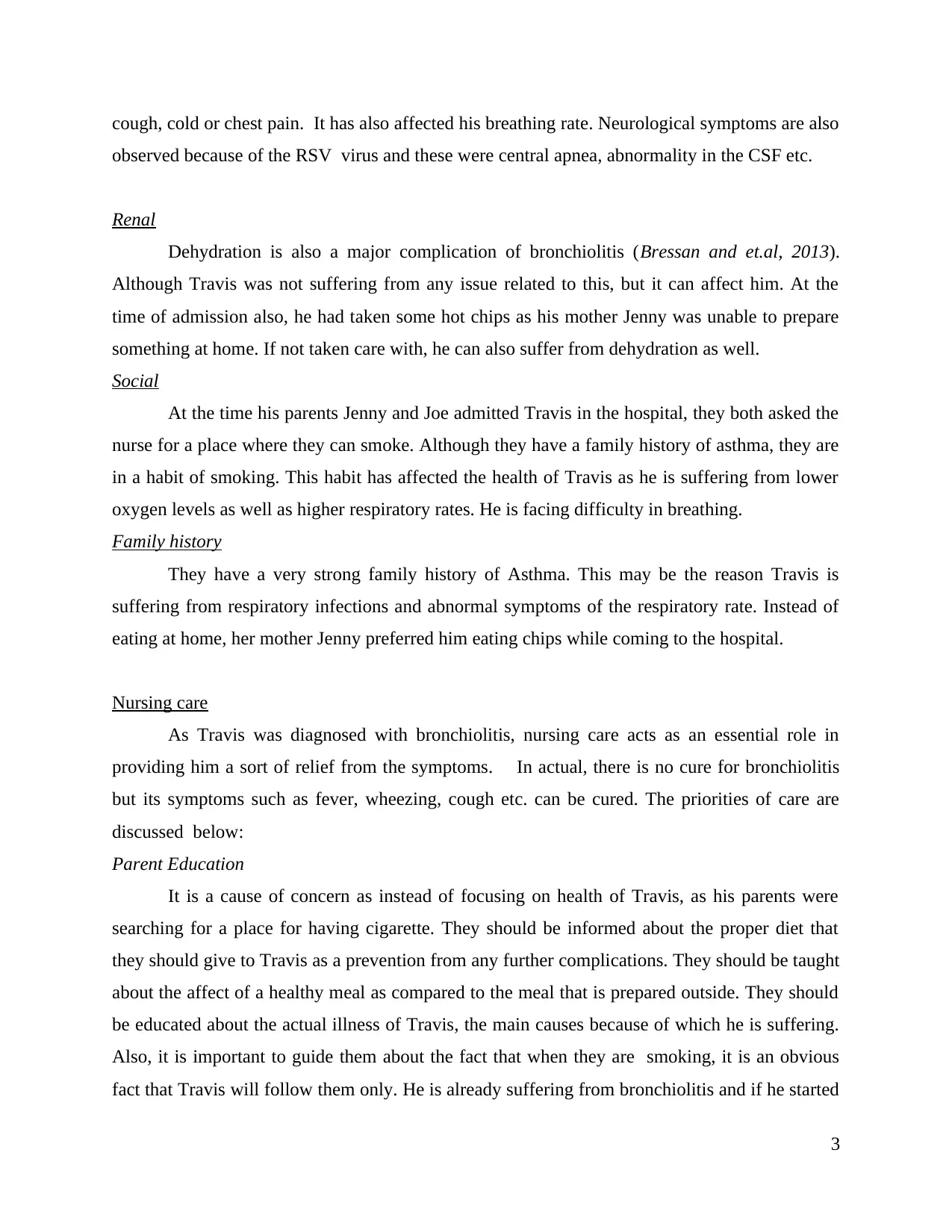
cough, cold or chest pain. It has also affected his breathing rate. Neurological symptoms are also
observed because of the RSV virus and these were central apnea, abnormality in the CSF etc.
Renal
Dehydration is also a major complication of bronchiolitis (Bressan and et.al, 2013).
Although Travis was not suffering from any issue related to this, but it can affect him. At the
time of admission also, he had taken some hot chips as his mother Jenny was unable to prepare
something at home. If not taken care with, he can also suffer from dehydration as well.
Social
At the time his parents Jenny and Joe admitted Travis in the hospital, they both asked the
nurse for a place where they can smoke. Although they have a family history of asthma, they are
in a habit of smoking. This habit has affected the health of Travis as he is suffering from lower
oxygen levels as well as higher respiratory rates. He is facing difficulty in breathing.
Family history
They have a very strong family history of Asthma. This may be the reason Travis is
suffering from respiratory infections and abnormal symptoms of the respiratory rate. Instead of
eating at home, her mother Jenny preferred him eating chips while coming to the hospital.
Nursing care
As Travis was diagnosed with bronchiolitis, nursing care acts as an essential role in
providing him a sort of relief from the symptoms. In actual, there is no cure for bronchiolitis
but its symptoms such as fever, wheezing, cough etc. can be cured. The priorities of care are
discussed below:
Parent Education
It is a cause of concern as instead of focusing on health of Travis, as his parents were
searching for a place for having cigarette. They should be informed about the proper diet that
they should give to Travis as a prevention from any further complications. They should be taught
about the affect of a healthy meal as compared to the meal that is prepared outside. They should
be educated about the actual illness of Travis, the main causes because of which he is suffering.
Also, it is important to guide them about the fact that when they are smoking, it is an obvious
fact that Travis will follow them only. He is already suffering from bronchiolitis and if he started
3
observed because of the RSV virus and these were central apnea, abnormality in the CSF etc.
Renal
Dehydration is also a major complication of bronchiolitis (Bressan and et.al, 2013).
Although Travis was not suffering from any issue related to this, but it can affect him. At the
time of admission also, he had taken some hot chips as his mother Jenny was unable to prepare
something at home. If not taken care with, he can also suffer from dehydration as well.
Social
At the time his parents Jenny and Joe admitted Travis in the hospital, they both asked the
nurse for a place where they can smoke. Although they have a family history of asthma, they are
in a habit of smoking. This habit has affected the health of Travis as he is suffering from lower
oxygen levels as well as higher respiratory rates. He is facing difficulty in breathing.
Family history
They have a very strong family history of Asthma. This may be the reason Travis is
suffering from respiratory infections and abnormal symptoms of the respiratory rate. Instead of
eating at home, her mother Jenny preferred him eating chips while coming to the hospital.
Nursing care
As Travis was diagnosed with bronchiolitis, nursing care acts as an essential role in
providing him a sort of relief from the symptoms. In actual, there is no cure for bronchiolitis
but its symptoms such as fever, wheezing, cough etc. can be cured. The priorities of care are
discussed below:
Parent Education
It is a cause of concern as instead of focusing on health of Travis, as his parents were
searching for a place for having cigarette. They should be informed about the proper diet that
they should give to Travis as a prevention from any further complications. They should be taught
about the affect of a healthy meal as compared to the meal that is prepared outside. They should
be educated about the actual illness of Travis, the main causes because of which he is suffering.
Also, it is important to guide them about the fact that when they are smoking, it is an obvious
fact that Travis will follow them only. He is already suffering from bronchiolitis and if he started
3
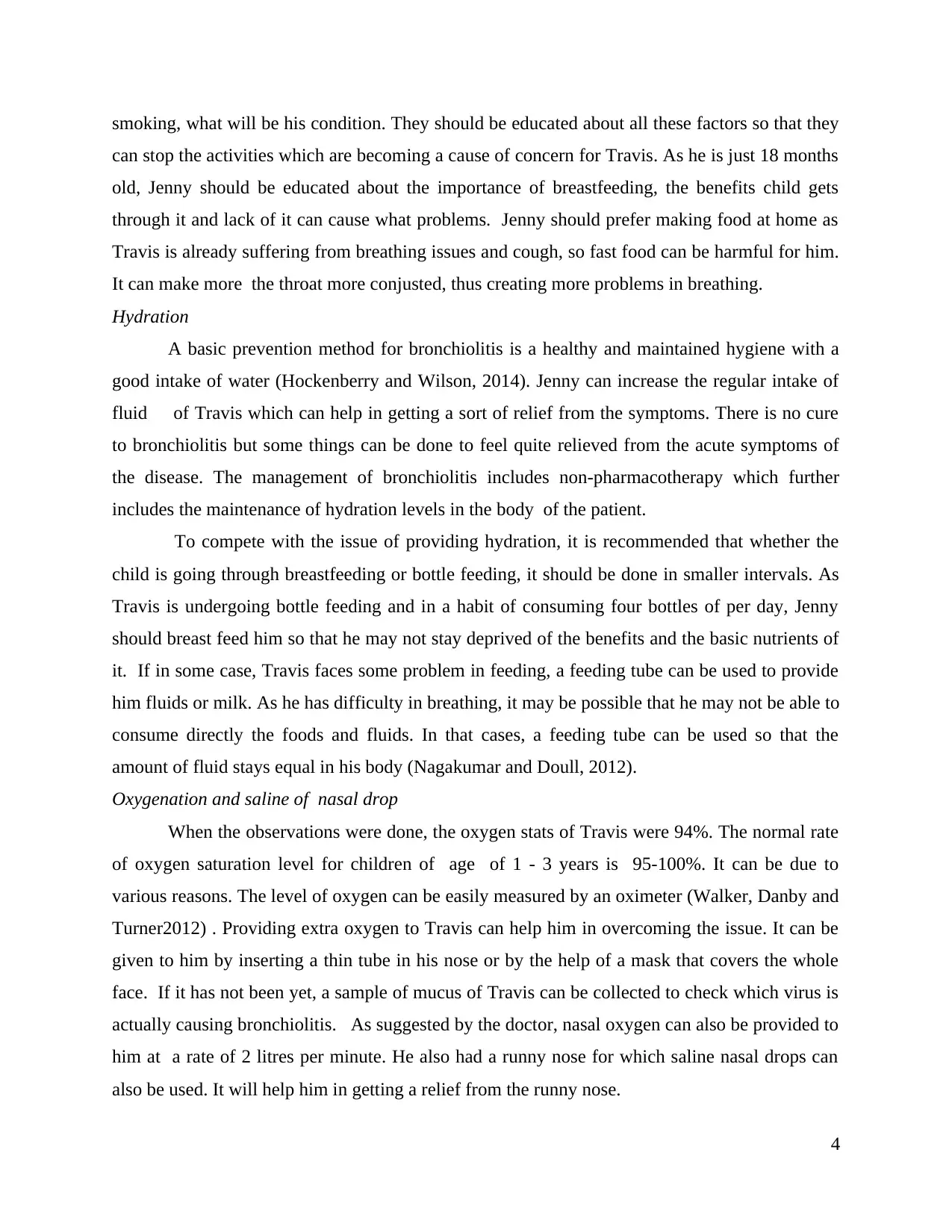
smoking, what will be his condition. They should be educated about all these factors so that they
can stop the activities which are becoming a cause of concern for Travis. As he is just 18 months
old, Jenny should be educated about the importance of breastfeeding, the benefits child gets
through it and lack of it can cause what problems. Jenny should prefer making food at home as
Travis is already suffering from breathing issues and cough, so fast food can be harmful for him.
It can make more the throat more conjusted, thus creating more problems in breathing.
Hydration
A basic prevention method for bronchiolitis is a healthy and maintained hygiene with a
good intake of water (Hockenberry and Wilson, 2014). Jenny can increase the regular intake of
fluid of Travis which can help in getting a sort of relief from the symptoms. There is no cure
to bronchiolitis but some things can be done to feel quite relieved from the acute symptoms of
the disease. The management of bronchiolitis includes non-pharmacotherapy which further
includes the maintenance of hydration levels in the body of the patient.
To compete with the issue of providing hydration, it is recommended that whether the
child is going through breastfeeding or bottle feeding, it should be done in smaller intervals. As
Travis is undergoing bottle feeding and in a habit of consuming four bottles of per day, Jenny
should breast feed him so that he may not stay deprived of the benefits and the basic nutrients of
it. If in some case, Travis faces some problem in feeding, a feeding tube can be used to provide
him fluids or milk. As he has difficulty in breathing, it may be possible that he may not be able to
consume directly the foods and fluids. In that cases, a feeding tube can be used so that the
amount of fluid stays equal in his body (Nagakumar and Doull, 2012).
Oxygenation and saline of nasal drop
When the observations were done, the oxygen stats of Travis were 94%. The normal rate
of oxygen saturation level for children of age of 1 - 3 years is 95-100%. It can be due to
various reasons. The level of oxygen can be easily measured by an oximeter (Walker, Danby and
Turner2012) . Providing extra oxygen to Travis can help him in overcoming the issue. It can be
given to him by inserting a thin tube in his nose or by the help of a mask that covers the whole
face. If it has not been yet, a sample of mucus of Travis can be collected to check which virus is
actually causing bronchiolitis. As suggested by the doctor, nasal oxygen can also be provided to
him at a rate of 2 litres per minute. He also had a runny nose for which saline nasal drops can
also be used. It will help him in getting a relief from the runny nose.
4
can stop the activities which are becoming a cause of concern for Travis. As he is just 18 months
old, Jenny should be educated about the importance of breastfeeding, the benefits child gets
through it and lack of it can cause what problems. Jenny should prefer making food at home as
Travis is already suffering from breathing issues and cough, so fast food can be harmful for him.
It can make more the throat more conjusted, thus creating more problems in breathing.
Hydration
A basic prevention method for bronchiolitis is a healthy and maintained hygiene with a
good intake of water (Hockenberry and Wilson, 2014). Jenny can increase the regular intake of
fluid of Travis which can help in getting a sort of relief from the symptoms. There is no cure
to bronchiolitis but some things can be done to feel quite relieved from the acute symptoms of
the disease. The management of bronchiolitis includes non-pharmacotherapy which further
includes the maintenance of hydration levels in the body of the patient.
To compete with the issue of providing hydration, it is recommended that whether the
child is going through breastfeeding or bottle feeding, it should be done in smaller intervals. As
Travis is undergoing bottle feeding and in a habit of consuming four bottles of per day, Jenny
should breast feed him so that he may not stay deprived of the benefits and the basic nutrients of
it. If in some case, Travis faces some problem in feeding, a feeding tube can be used to provide
him fluids or milk. As he has difficulty in breathing, it may be possible that he may not be able to
consume directly the foods and fluids. In that cases, a feeding tube can be used so that the
amount of fluid stays equal in his body (Nagakumar and Doull, 2012).
Oxygenation and saline of nasal drop
When the observations were done, the oxygen stats of Travis were 94%. The normal rate
of oxygen saturation level for children of age of 1 - 3 years is 95-100%. It can be due to
various reasons. The level of oxygen can be easily measured by an oximeter (Walker, Danby and
Turner2012) . Providing extra oxygen to Travis can help him in overcoming the issue. It can be
given to him by inserting a thin tube in his nose or by the help of a mask that covers the whole
face. If it has not been yet, a sample of mucus of Travis can be collected to check which virus is
actually causing bronchiolitis. As suggested by the doctor, nasal oxygen can also be provided to
him at a rate of 2 litres per minute. He also had a runny nose for which saline nasal drops can
also be used. It will help him in getting a relief from the runny nose.
4
⊘ This is a preview!⊘
Do you want full access?
Subscribe today to unlock all pages.

Trusted by 1+ million students worldwide
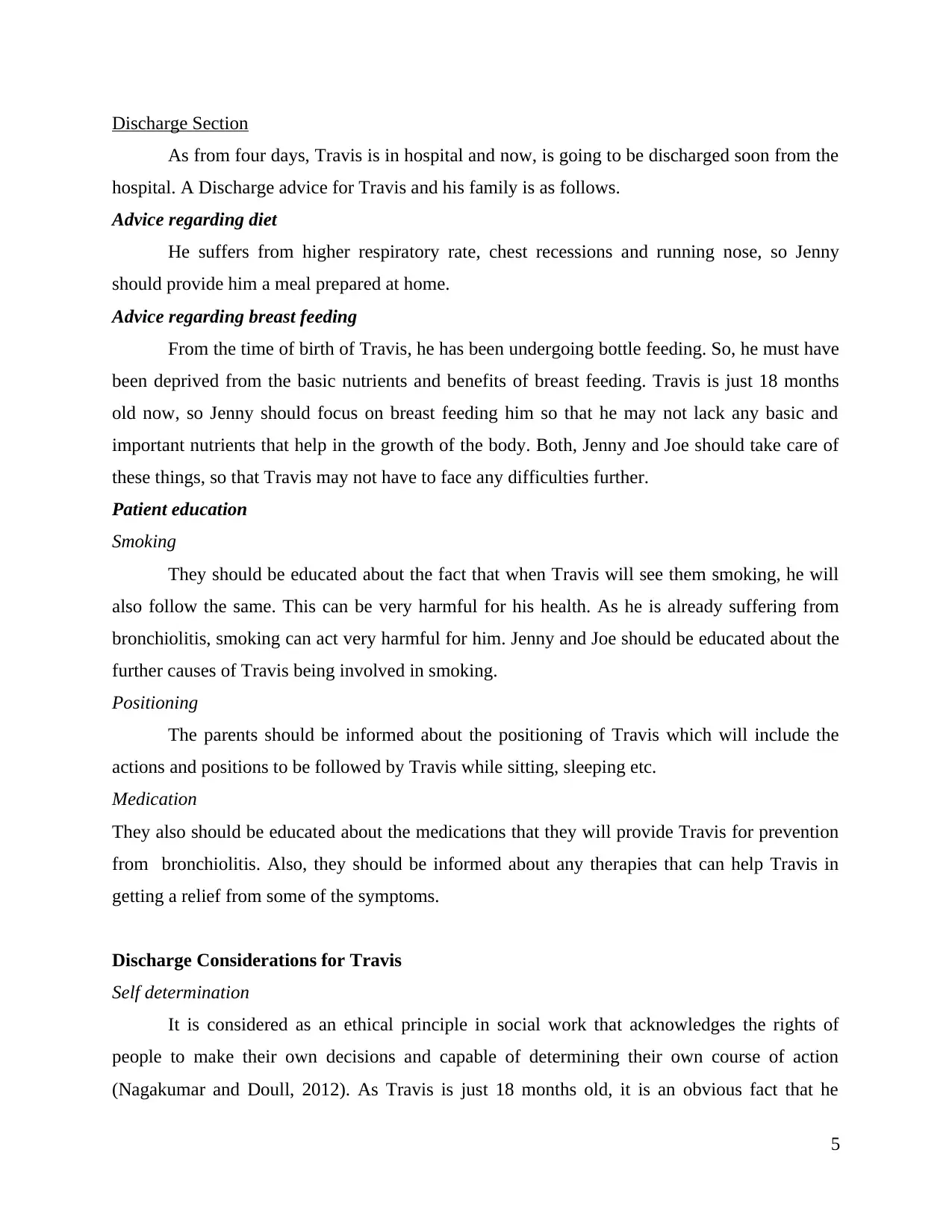
Discharge Section
As from four days, Travis is in hospital and now, is going to be discharged soon from the
hospital. A Discharge advice for Travis and his family is as follows.
Advice regarding diet
He suffers from higher respiratory rate, chest recessions and running nose, so Jenny
should provide him a meal prepared at home.
Advice regarding breast feeding
From the time of birth of Travis, he has been undergoing bottle feeding. So, he must have
been deprived from the basic nutrients and benefits of breast feeding. Travis is just 18 months
old now, so Jenny should focus on breast feeding him so that he may not lack any basic and
important nutrients that help in the growth of the body. Both, Jenny and Joe should take care of
these things, so that Travis may not have to face any difficulties further.
Patient education
Smoking
They should be educated about the fact that when Travis will see them smoking, he will
also follow the same. This can be very harmful for his health. As he is already suffering from
bronchiolitis, smoking can act very harmful for him. Jenny and Joe should be educated about the
further causes of Travis being involved in smoking.
Positioning
The parents should be informed about the positioning of Travis which will include the
actions and positions to be followed by Travis while sitting, sleeping etc.
Medication
They also should be educated about the medications that they will provide Travis for prevention
from bronchiolitis. Also, they should be informed about any therapies that can help Travis in
getting a relief from some of the symptoms.
Discharge Considerations for Travis
Self determination
It is considered as an ethical principle in social work that acknowledges the rights of
people to make their own decisions and capable of determining their own course of action
(Nagakumar and Doull, 2012). As Travis is just 18 months old, it is an obvious fact that he
5
As from four days, Travis is in hospital and now, is going to be discharged soon from the
hospital. A Discharge advice for Travis and his family is as follows.
Advice regarding diet
He suffers from higher respiratory rate, chest recessions and running nose, so Jenny
should provide him a meal prepared at home.
Advice regarding breast feeding
From the time of birth of Travis, he has been undergoing bottle feeding. So, he must have
been deprived from the basic nutrients and benefits of breast feeding. Travis is just 18 months
old now, so Jenny should focus on breast feeding him so that he may not lack any basic and
important nutrients that help in the growth of the body. Both, Jenny and Joe should take care of
these things, so that Travis may not have to face any difficulties further.
Patient education
Smoking
They should be educated about the fact that when Travis will see them smoking, he will
also follow the same. This can be very harmful for his health. As he is already suffering from
bronchiolitis, smoking can act very harmful for him. Jenny and Joe should be educated about the
further causes of Travis being involved in smoking.
Positioning
The parents should be informed about the positioning of Travis which will include the
actions and positions to be followed by Travis while sitting, sleeping etc.
Medication
They also should be educated about the medications that they will provide Travis for prevention
from bronchiolitis. Also, they should be informed about any therapies that can help Travis in
getting a relief from some of the symptoms.
Discharge Considerations for Travis
Self determination
It is considered as an ethical principle in social work that acknowledges the rights of
people to make their own decisions and capable of determining their own course of action
(Nagakumar and Doull, 2012). As Travis is just 18 months old, it is an obvious fact that he
5
Paraphrase This Document
Need a fresh take? Get an instant paraphrase of this document with our AI Paraphraser
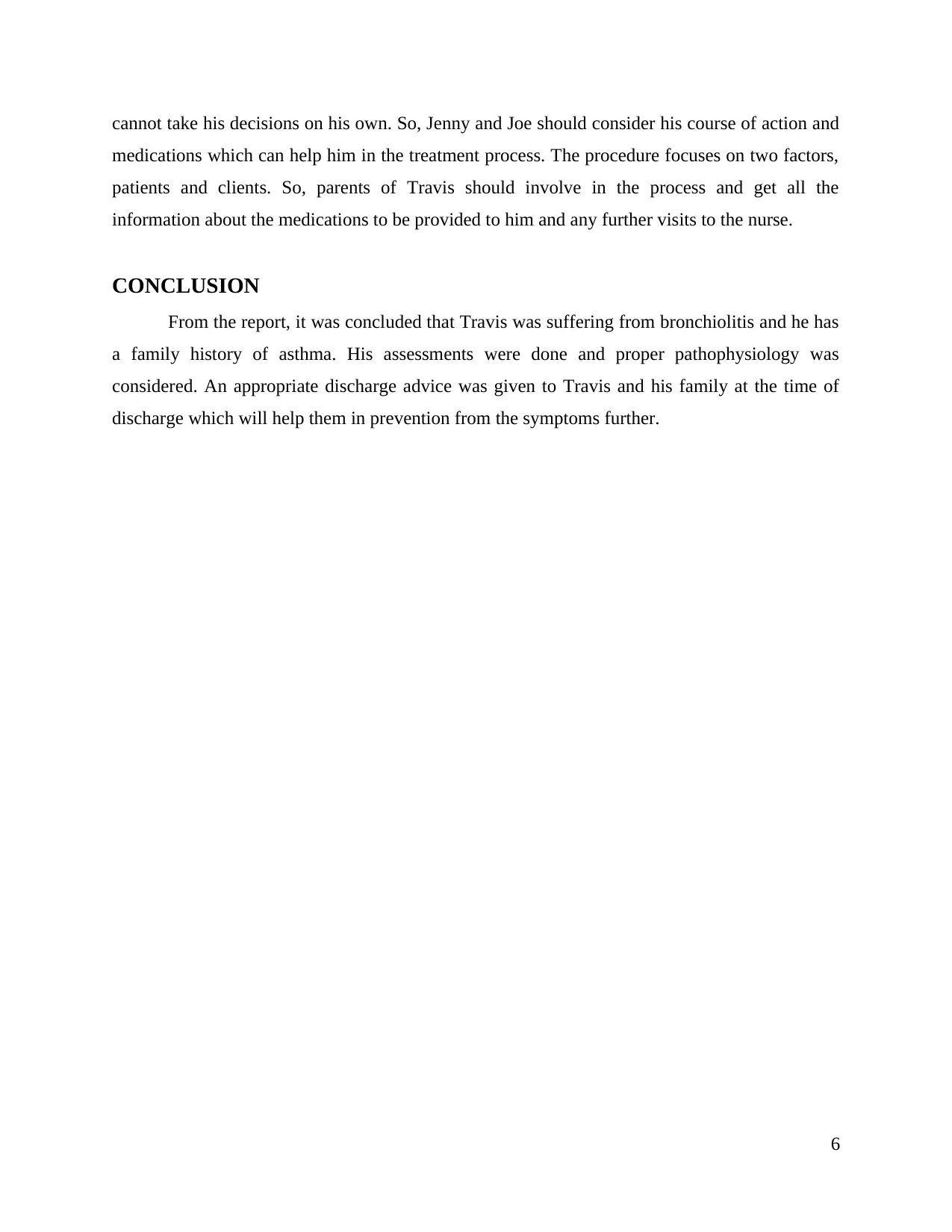
cannot take his decisions on his own. So, Jenny and Joe should consider his course of action and
medications which can help him in the treatment process. The procedure focuses on two factors,
patients and clients. So, parents of Travis should involve in the process and get all the
information about the medications to be provided to him and any further visits to the nurse.
CONCLUSION
From the report, it was concluded that Travis was suffering from bronchiolitis and he has
a family history of asthma. His assessments were done and proper pathophysiology was
considered. An appropriate discharge advice was given to Travis and his family at the time of
discharge which will help them in prevention from the symptoms further.
6
medications which can help him in the treatment process. The procedure focuses on two factors,
patients and clients. So, parents of Travis should involve in the process and get all the
information about the medications to be provided to him and any further visits to the nurse.
CONCLUSION
From the report, it was concluded that Travis was suffering from bronchiolitis and he has
a family history of asthma. His assessments were done and proper pathophysiology was
considered. An appropriate discharge advice was given to Travis and his family at the time of
discharge which will help them in prevention from the symptoms further.
6
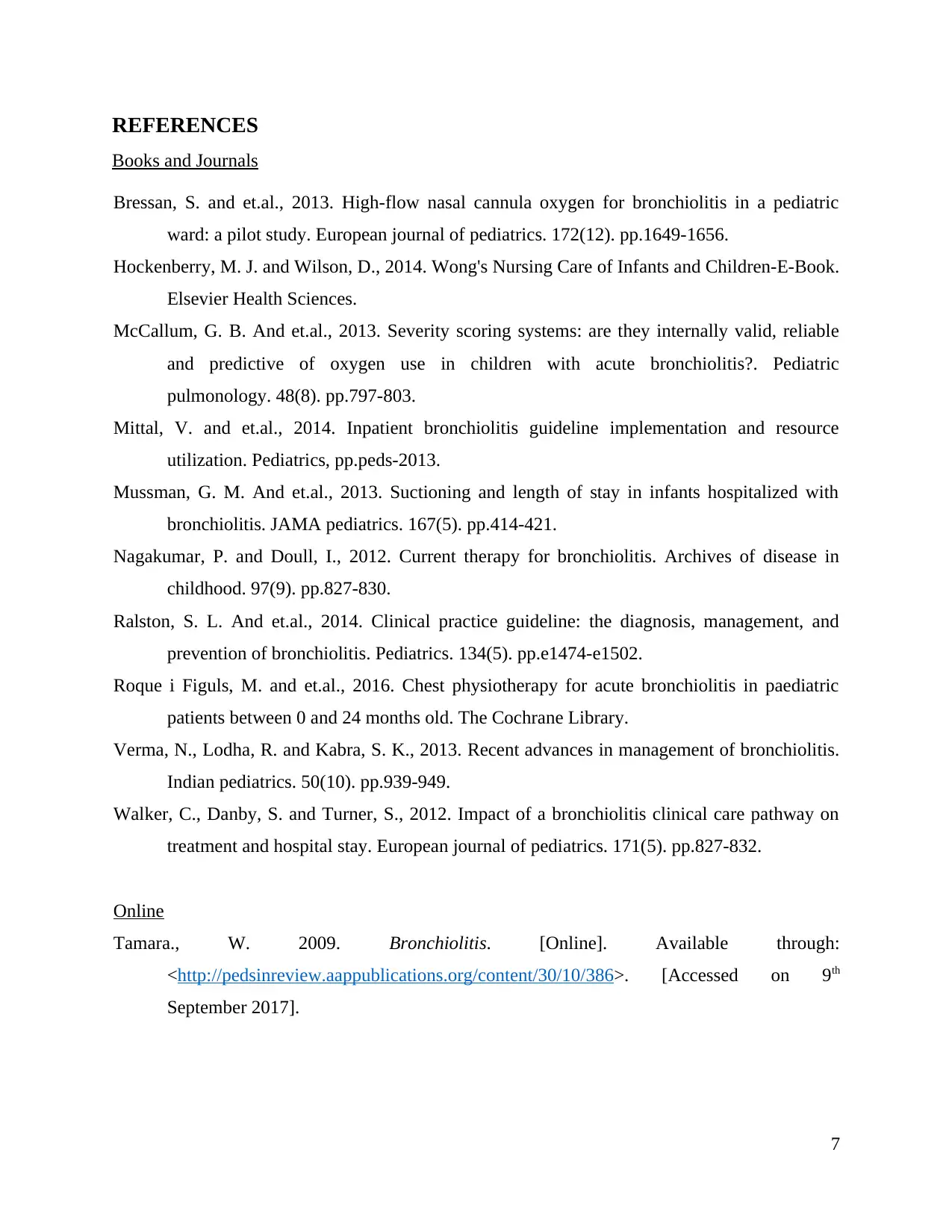
REFERENCES
Books and Journals
Bressan, S. and et.al., 2013. High-flow nasal cannula oxygen for bronchiolitis in a pediatric
ward: a pilot study. European journal of pediatrics. 172(12). pp.1649-1656.
Hockenberry, M. J. and Wilson, D., 2014. Wong's Nursing Care of Infants and Children-E-Book.
Elsevier Health Sciences.
McCallum, G. B. And et.al., 2013. Severity scoring systems: are they internally valid, reliable
and predictive of oxygen use in children with acute bronchiolitis?. Pediatric
pulmonology. 48(8). pp.797-803.
Mittal, V. and et.al., 2014. Inpatient bronchiolitis guideline implementation and resource
utilization. Pediatrics, pp.peds-2013.
Mussman, G. M. And et.al., 2013. Suctioning and length of stay in infants hospitalized with
bronchiolitis. JAMA pediatrics. 167(5). pp.414-421.
Nagakumar, P. and Doull, I., 2012. Current therapy for bronchiolitis. Archives of disease in
childhood. 97(9). pp.827-830.
Ralston, S. L. And et.al., 2014. Clinical practice guideline: the diagnosis, management, and
prevention of bronchiolitis. Pediatrics. 134(5). pp.e1474-e1502.
Roque i Figuls, M. and et.al., 2016. Chest physiotherapy for acute bronchiolitis in paediatric
patients between 0 and 24 months old. The Cochrane Library.
Verma, N., Lodha, R. and Kabra, S. K., 2013. Recent advances in management of bronchiolitis.
Indian pediatrics. 50(10). pp.939-949.
Walker, C., Danby, S. and Turner, S., 2012. Impact of a bronchiolitis clinical care pathway on
treatment and hospital stay. European journal of pediatrics. 171(5). pp.827-832.
Online
Tamara., W. 2009. Bronchiolitis. [Online]. Available through:
<http://pedsinreview.aappublications.org/content/30/10/386>. [Accessed on 9th
September 2017].
7
Books and Journals
Bressan, S. and et.al., 2013. High-flow nasal cannula oxygen for bronchiolitis in a pediatric
ward: a pilot study. European journal of pediatrics. 172(12). pp.1649-1656.
Hockenberry, M. J. and Wilson, D., 2014. Wong's Nursing Care of Infants and Children-E-Book.
Elsevier Health Sciences.
McCallum, G. B. And et.al., 2013. Severity scoring systems: are they internally valid, reliable
and predictive of oxygen use in children with acute bronchiolitis?. Pediatric
pulmonology. 48(8). pp.797-803.
Mittal, V. and et.al., 2014. Inpatient bronchiolitis guideline implementation and resource
utilization. Pediatrics, pp.peds-2013.
Mussman, G. M. And et.al., 2013. Suctioning and length of stay in infants hospitalized with
bronchiolitis. JAMA pediatrics. 167(5). pp.414-421.
Nagakumar, P. and Doull, I., 2012. Current therapy for bronchiolitis. Archives of disease in
childhood. 97(9). pp.827-830.
Ralston, S. L. And et.al., 2014. Clinical practice guideline: the diagnosis, management, and
prevention of bronchiolitis. Pediatrics. 134(5). pp.e1474-e1502.
Roque i Figuls, M. and et.al., 2016. Chest physiotherapy for acute bronchiolitis in paediatric
patients between 0 and 24 months old. The Cochrane Library.
Verma, N., Lodha, R. and Kabra, S. K., 2013. Recent advances in management of bronchiolitis.
Indian pediatrics. 50(10). pp.939-949.
Walker, C., Danby, S. and Turner, S., 2012. Impact of a bronchiolitis clinical care pathway on
treatment and hospital stay. European journal of pediatrics. 171(5). pp.827-832.
Online
Tamara., W. 2009. Bronchiolitis. [Online]. Available through:
<http://pedsinreview.aappublications.org/content/30/10/386>. [Accessed on 9th
September 2017].
7
⊘ This is a preview!⊘
Do you want full access?
Subscribe today to unlock all pages.

Trusted by 1+ million students worldwide

8
1 out of 10
Related Documents
Your All-in-One AI-Powered Toolkit for Academic Success.
+13062052269
info@desklib.com
Available 24*7 on WhatsApp / Email
![[object Object]](/_next/static/media/star-bottom.7253800d.svg)
Unlock your academic potential
Copyright © 2020–2025 A2Z Services. All Rights Reserved. Developed and managed by ZUCOL.




